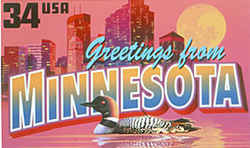


Minnesota Early History
First Early Inhabitants of Minnesota

Early history examines the archaeological record that tells the story of the first inhabitants of Minnesota. Learn about the prehistory and culture of the first early inhabitants, and what lessons it might teach us about the early history of Minnesota.
Minnesota First Early Inhabitants Timeline
- Game or PaleoIndians: before 5,000 BC
- one of the first discoveries archeologists made of so-called "pre-historic"people was the now famous Browns Valley Man at the western edge of what's now MN (8,000 to 9,000 BC)
- the skeleton of a girl - misnamed "MN Man"- was found near present day Pelican Rapids and which could be as old as 25,000 BC
- a third skeleton - found near Sauk Rapids - seems to be from the same era
- Eastern Archaic: 5,000 to 1,000 BC
- this is the beginning of cultural differences between locations
- so-called "sites" of these Native people have been found: near Mille Lacs, in SE MN, in Stearns Co in central MN (near western edge), Itasca State Park (near the White Earth reservation and where the Mississippi River begins)
- the skeleton of a dog first in MN was found (Dogs have always been very important to Ojibwe because of their relationship to the wolf - a sacred relative of the People).
- Woodland: 1,000 BC to 1,700 AD
- this area was on the northwest edge of this culture, which had major centers in what is now Ohio and Illinois (called Hopewell community)
- the earliest Woodland sites found thus far where people lived are the LaMoille Rock Shelter south of Winona and the Schilling site at the tip of Grey Cloud Island in the Mississippi River below St. Paul
- sometime after 500 BC influences from the Illinois Hopewell center began to penetrate the state via the Mississippi River route
- Mississippian: 1,000 AD to 1,700 AD
- a tradition born in the southern US and exhibiting strong Mexican influences, found its way to this area during this period
- the largest infusion came up the Mississippi River and by 1,000 AD two major centers were established
- villages were fairly large - from 600 to 800 people - sometimes surrounded by a protective wall, located on flat river terraces above rich bottom lands
- tools continued to be made from stone. Large double pointed knives and trapezoidal hide scrapers indicate the people used animal hides for clothes
- 1659 - Between 1659-1660 French fur traders Pierre-Esprit Radisson (1636 - 1710) and Médard Chouart, Sieur des Groseilliers (1618 - 1710) explore western end of Lake Superior
- 1679 - Daniel Greysolon, Sieur du Luth (1636–1710) claims the upper Mississippi region for France
1770 - Grand Portage is established as the fur trading crossroads in northern Minnesota (1770 -1804)
Early History of Native Americans in Minnesota
The Indigenous People of Minnesota
The names of the Minnesota tribes included the Arapaho, Cheyenne, Chippewa, Dakota Sioux, Fox and Sauk. Woodland tribes were the Iowa, Omaha, Otoe, Ottawa, Ponca (see above picture), Winnebago and Huron (aka the Wyandot).Archaeologists tell us that four separate cultures lived in the general area that would one day become Minnesota. The Big Game
or Paleo-Indian culture inhabited the area before 5,000 BC, and were part of a larger group that existed throughout North America. The people were
nomadic, living in small groups of extended families. They made tools by chipping rocks into spears and knives, wore clothes made of animal skills,
lived in temporary shelters, and used fire for heat and cooking.
The Eastern Archaic people lived in the area between 5,000 and 1,500 BC. They expanded their use of natural resources and used copper, granite and
basalt to make more sophisticated tools. They were still semi-nomadic, which means they moved from place to place according to the season. They began
to harvest wild vegetables like acorns to supplement their diet.
The Woodland people were prominent between 1,000 BC and 1,700 AD They developed the ability to harvest wild rice, and their population grew significantly.
This led to the establishment of permanent villages. The people hunted bison, deer, moose, raccoon, rabbit, muskrat and beaver for their meat and their
fur and skins. Although they used copper for tools, the supply of copper became scarce in later years, and they began to carve tools out of bone and
antlers. They also used shells and bone to make ornaments. The pottery they used leads archaeologists to believe these people may have been related
to people who lived earlier in the Ohio Valley, and who had migrated west along the Mississippi River. The Woodland people are also known for building
elaborate burial mounds in which to bury their dead.
The Mississippian culture (1,000 AD - 1,700 AD) existed at the same time as the Woodland culture, but seems to have been rooted in the southern part
of the continent, and it had strong Mexican influences. These people probably migrated north along the Mississippi River. They built fairly large villages
of 600 - 800 people, sometimes surrounded by a protective wall. They used bone tools as well as tools made from stone. Jewelry and pottery found in
their villages indicate that they traded with people from other parts of North America.
By the late eighteenth century, two main tribes were living in the area we now call Minnesota: the Dakota Sioux and the Ojibwa. In 1745, the Ojibwa
won a decisive battle against the Dakota Sioux and began to drive them west and south.





